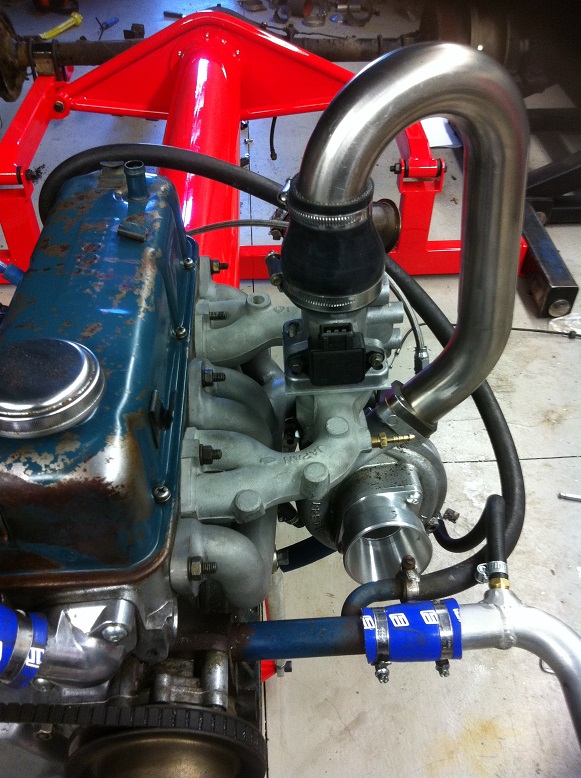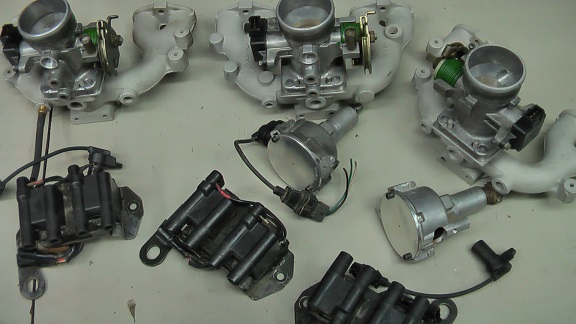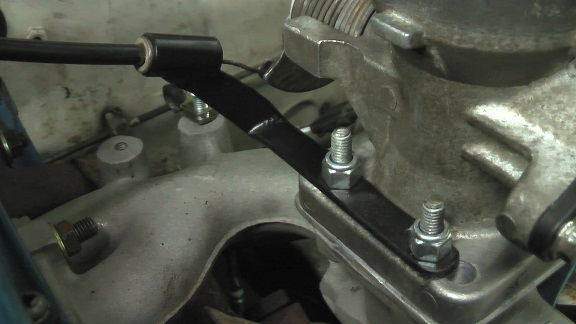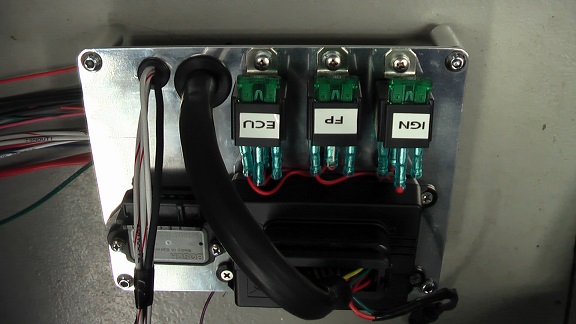How to build a cost effective EFI turbo setup that is upgradeable in the future: Big Power from stock-block A12 can be had by adding a turbocharger. A formula for new-style A12 (1974-1994) has been developed by the legendary sikyne. With unmodified stock A12 it makes 127 HP. This turbo setup on an A12 makes more power and torque than a worked non-turbo A14, for a fraction of the build cost.
Contents |
A12 Overview
- Turbo EFI A12 for under $1200. Build thread
- Forum: Turbo EFI A12 for under $1200. Discussion thread post your questions here
- A12 Turbo Development thread (for background info)
The $1200 AUD setup uses the standard A12 inlet manifold fitted with a single Throttle Body and a single injector. The ECU is a MicroSquirt V3, which allows for future upgrades like adding multiple coils and injectors later, as well as boost control. Turbo is a single turbo from a twin turbo Nissan Skyline. And there are plenty of Upgrade options if you want more power later on.
80.7 Kw @ 6100 RPM with 12 lbs boost PULP 94.5Kw intercooled with 14 lbs boost (127 hp) fuel injected with ECU ignition control 2nd-hand GT2860R turbo, upgraded to inconel Premium Unleaded Petrol, 98 RON octane (92 R+M/2) stock and unmodified A12 head stock pistons, crank and rods standard head gasket
Pluses: * uses the standard 4-speed gearbox * uses the standard 1200 diff * tested with RHD Datsun 1200, may fit others * tested with new A12 (1974-1994 style) will not work with 1970-1973 A12 due to alternator location
Simon: This is a stock A12 motor from eBay. Original round port head, head bolts, standard head gasket, inlet manifold etc. Just 1 injector pointing into the turbo compressor and a 40mm throttle body bolted to the original manifold.
Not needed * EGO sensor * O2 sensor * dyno tuning. A12 outfitted to this formula can use a standardized tuning file
Think this is great? An A12 can do so much moreAn Unmodified A12 short block with stock pistons, crank and rods, and standard head gasket makes 160HP] intercooled on E85 ethanol alcohol fuel using stock unmodified H89 A14 cylinder head. See sikyne A12 Turbo
Engine
The turbo exhaust manifold shown below was designed and tested with the newer A12 (1974 and newer). It may not fit a B110 A12 (1970-1973) due to the alternator location being on the manifold side of the engine.
The manifold was also tested on a RHD 1200, but it appears it may fit LHD 1200s too (even though LHD models have the steering gearbox on the manifold side of the engine bay).
However, other turbo exhaust manifold designs might work. The turbo manifold is the only piece of the $1200 formula that limits the type of A12. All the other parts (ECU, intake manifold, etc) work with any type of 1200.
Low-profile engine mount may help fit it to an original-style A12.

Head Gasket
Standard A12 head gasket was used (Durapro brand, $18 AUD).
Cylinder Head
Stock late-model A12 cylinder head was used (8.5:1 compression ratio?). Early A12s are 9:1.
A light skim of the A12 head can be done, not to raise compression but to recondition a warped head.
Camshaft
236 deg at .050"
Contact sikyne for the exact cam details.
NOTE: The stock A12 camshaft is 248 degrees "advertised" duration. Advertised duration gives a bigger number, and will be less when measured at .050" lift.
Manifolds
Inlet Manifold
Rather than fabricate a custom manifold, the stock one works well for a road car with a mild cam. On a turbo engine, boost is usually the thing that has the biggest impact on the torque curve. Much more so than intake manifold runner length or even runner diameter.
Unbolt the A12 intake from the exhaust, then fit short bolts into the holes to hold the bottom plate on. 3-bolt shown, some are 4-bolt

Parts needed:
- Stock A12 intake manifold
- #Throttle body (40mm) from a Hyundai Excel/Accent X3 SOHC
- #Fuel pressure regulator from a circa 1997 Misubishi Lancer or Toyota Corolla
- 3-5mm thick alloy plate for the adaptor
- 1 #Fuel Injector (1000cc for petrol)
The X3 Excel Throttle Body is dime a dozen, easy to adapt and seal a boost hose into the top. They normally run 15 psi.
Mounting the injector, fuel rail and fuel pressure regulator

Manifold Heat
Since the formula is not using the standard heated intake system (Heat Riser or water-heated manifold), under light-throttle conditions it may not run perfect.
post: At part load, between 2k and 2500 rpm, it seems to have poor mixture preparation causing the fuel to drop out of suspension. It is fixed by preheating the air going into the throttle body. I don't think it would be a problem if the manifold was water heated or the factory exhaust manifold was still bolted to the inlet. Without preheating the air, no amount of timing change or fueling change fixes it. Its perfect at every other rpm and load.
Exhaust Manifold
UPDATE: For the $1200 formula, any turbo manifold can be used that supports the T2 flange.
sikyne can build you the manifold documented here, but for a price.
The turbo manifold is fairly basic, a variation of a log style manifold, as merge collectors can be a bit tricky and take up a lot more space.
The turbo is mounted low and rearward, and angled down slightly at the back. It hides well (for that stealth look) and the tilt down at the rear makes the dump pipe easier and cheaper to install and fabricate (less bends, better access).
Ignition
Use a Hyundai coil pack. Although others can be used, you can obtain it from the same car the EFI parts come from.

Ignition timing is: 30deg BTDC at 100Kpa (atmospheric pressure) at peak torque.
Recommended ignition module is the two-channel Bosch 0227100200 module. Alternatively Convert a points distributor to a hall input trigger for the MicroSquirt
Ignition modules can be either two single-channel units like the Bosch 0227100124 or a two channel module like the Bosch 0227100200. Another choice is SH ignition module, or you can use a BIP373 unit instead for budget choice. You can run 4 individual coils also (if you like the look) by using a 4 channel module like the Bosch 211($$$), but they will still be firing wasted spark (two at one time) when using the MicroSquirt V3.
NOTE: MegaSquirt V3 comes with BIP373 built-in. MicroSquirt V3 does not.
Fabricate an EI Trigger
If you are not going to use the points distributor, here are the parts needed to convert it to EI and use the Bosch unit:
- Stock Datsun 1200 Hitachi OR Lucas Australia distributor
- Hyundai Excel/Accent (1995-1999) #cam sensor
- 12 tooth motorbike sprocket ($9) , remove one tooth
- 6mm allthread (50mm length)
- Two 6mm nyloc nuts and one plain nut
- Two 6mm washers
- Hyundai #coil pack
A Hall-effect sensor is used instead of a simple VR (magnetic) sensor, as the Hall adds a built-in signal amplifier to a VR, producing a stronger signal. This is less susceptible to wiring issues.
ECU
MicroSquirt V3 is very capable and costs about $575 AUD. The Micro 'Squirt is basically a MegaSquirt 2 in a smaller package. Sellers
If you use this ECU and the same parts (injector, manifold, etc), a tune file from Sikyne is all you need for near-perfect tuning.
* Tune file: Contact sikyne
You might find less expensive ECUs second-hand, but this is commonly available and can do many things the high-dollar ECUs do, so it has room to grow if you wish to makes changes later on. For example, you fabricate a new 4 injector manifold later. You can run it semi sequential using one injector diver for 2 cyl and the other for the other two. It can also be configured to run 4 ignition coils. Although it won't do sequential EFI like the more expensive MegaSquirt V3, it won't limit power potential.
Boost
The MicroSquirt uses electronic boost control to limit mechanical overload of the piston, to avoid breaking the ring lands or flexing the pin and distorting the piston. These stresses are highest at peak torque. The stock A12 pistons have been surviving at 150 lb ft, so to maintain that torque (average cylinder pressure) higher into the rev range requires more boost up high.
Parts
Basic Kit $725 AUD (limited run, no longer available, minimum order 5 kits)
- Throttle body, modified to fit manifold and tapped to suit the air temp sensor, TPS and wiring plug.
- Inlet manifold, garnet blasted and opened up to fit the TB inc. adaptor plate. drilled for injector. brass fitting and FPR hose.
- Fuel rail, bracket, regulator and new $100 large injector
- Hyundai Coil pack
- Modified distributor, new trigger wheel, Hyundai sensor, alloy cover and bolts, with wiring plug.
- Turbo manifold, fully welded
- Turbo crossover pipe, Stainless steel
- Turbo hoses and clamps
In addition to the kit, these parts are needed:
- #MicroSquirt V3
- Accelerator cable brackets off original 1200 carburetor
- Wiring and #sensors
- Fuel pump and second line
- Turbo and associated plumbing
- Post-turbo exhaust
- Wiring loom
- #Ignition module
Hyundai Parts
parts: The 1995-1999 Hyundai Excel X3 (Accent in USA) SOHC engine is the source for the 1) Throttle Body, 2) Cam Positioning Sensor and 3) coil pack. don't forget to get the wiring harness connectors and a couple of inches of wiring for each of these components.
Fuel Pressure Regulator
Fuel Pressure regulator from a 1997-2001 Misubishi Lancer 1.5 engine, $15 used
Search $35 RockAuto.com 51 psi BECK/ARNLEY 1580463 {#MD311979) STANDARD MOTOR PRODUCTS PR247 AIRTEX / WELLS 5G1265 Denso MD 311979
Mitsubishi Lancer/Colt/Mirage 1997-2001

Turbo
2nd-hand GT2860R (707160-5) ball bearing turbo from R32 Skyline, upgraded with Inconel wheel.
Stock Turbo off twin-turbo Skyline ($100 secondhand) is limited to about 12-14psi because they are made with a ceramic turbine impeller. Much more boost than this, these turbines tend to fly apart. Upgrade to Inconel steel turbine wheel and rebuilt kit is about $380, but allows higher boost.
Injector
Seimens Deka 800cc Injector
Sensors
The Delco air and water temp sensors can be found on GM V6 engines and others from the 1990s, get the connectors for these while you are there.
You will also need a GM 3-bar map sensor and connector, but these wont be available at wreckers.
Mount the air temperature sensor

Air Temperature Sensor
Turbocharged engines should use an open-element air temperature sensor for a faster response time, such as GM 25036751.
- Obtain GM IAT sensor from a Chevrolet or Holden
- Or one might come with your MicroSquirt
Also see: EFI Sensor
Water Temperature Sensor
Coolant temperature sensor (CLT), such as GM 12146312
Does this bolt into the unmodified A12 cylinder head?
3-bar MAP Sensor
GM makes a 3.0 boost MAP sensor: GM 16040749
Costs
2015 AUD costs by Simon
$550. New Microsquirt V3 ECU, loom, sensors. $30. Coil pack(Excel). $30. Throttle body, inc tps and harness plug(excel). $92. new Seimens Deka 800cc Inj(Ebay). $15. SH Fuel pressure reg(97 Mitsu Lancer) $14. Brass "T" (1/4 BSP), barbed fitting, angle brackets for Fuel rail. $15. Cam sensor (Excel) $8.50 12 tooth sprocket(Ebay, inc delivery) $5. Alloy for TB adaptor plate and dizzy cover. $35. Extra wiring and heat shrink. $60. SH Ign module(can use BIP 373 transistors instead $10 each). $60. Fuel pump $50. Extra fuel line. $7.50 EFI filter.
Turbo Manifold Turbo
Fuel Pump and Fuel Lines
Do we need to add a new fuel supply tap to the fuel tank?
EFI requires a high pressure pump, at least 14 psi, but in this case 51 psi. You can use a generic EFI pump like the famous Walbro 255: $127 USD and up
The standard fuel pump is bypassed -- just leave it in place, and disconnect the fuel lines from it. Or you can unbolt it and fit a blockoff plate like Nissan 16420-E0100.
Use the original carb feed line as a fuel return line. Remove all these original metal lines from the engine and run hose from the FPR (fuel pressure regulator) straight to the original hard line on the firewall. Remove the standard steel fuel line around the front of the valve cover. Both the feed and return lines follow each other behind the engine. The FPR is positioned so the line points toward the rear.
Relays
The relays have fuses mounted in the top of them to save mounting extra fuses. Just saves a bit of wiring. The fuses are not fitted in the pic.
- Also see: EFI Wiring
Required Upgrades
Cooling System
You will need a radiator capable of cooling a 127 hp engine, like the N14 radiator swap. See Radiator Upgrades
* Large radiator * 71C thermostat * 16 psi high-pressure Radiator Cap
Clutch
With this much torque, the stock clutch won't last long. See Performance Clutches. Mainly what is needed is a higher-pressure Clutch Cover (the disc type is less important).
Racing
For racing: * add Oil Cooler to keep temps at 100c
Engine Life
At the 11 psi boost level, I'd expect 100,000 km on a road car with sensible rev limits and general good treatment. Or a season of racing. But get something wrong with the tune and it might last 5 minutes if its allowed to detonate.
- With moderate boost, the peak cylinder pressure isn't much higher than a non-boosted engine. But the pressure is maintained for more of the power stroke. Because of this, loads on rods and bearings don't go up much. Its more a matter of thermal management, things like pistons and cooling systems can be quickly overcome because the extra time the force/heat is applied per power stroke.
- Ring wear would go up a bit because its forced against the bore longer on each power stroke compared to naturally aspirated (NA).
- Keeping the standard pistons from overheating is probably the biggest concern. That's where E85 can be a huge help. Good intercooling plays a big part too.
- The engine management system can also play a big part in saving an engine. Things like Compensation tables set up to retard ignition as intake temps rise or Electronic boost control backing off boost if EGT's get a bit high.

![[Datsun 1200 encyclopedia]](/wiki/upload/wiki.png)


















